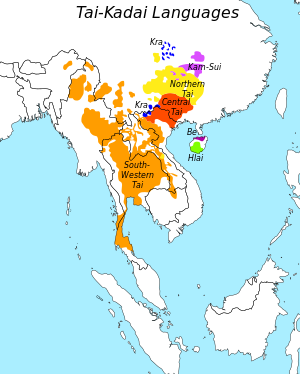크라다이어족
크라다이어족(영어: Kra-Dai languages) 또는 타이카다이어족(영어: Tai-Kadai languages)은 동남아시아와 중국 남부에서 사용되는 여러 언어들의 어족이다. 대부분 성조를 음운적 특징으로 가진다. 크라다이어족을 중국 티베트어족의 중국어파, 티베트 버마어파 및 미얀마야오어 (미얀마야오어족 Miao-Yao))와 함께 중국 티베트제어라고 부른다.[2][3]
| 크라다이어족 타이카다이, 따이까다이, 다이 | |
|---|---|
| 지리적 분포 | 중국 남부, 하이난섬, 인도차이나반도, 인도 북동부 |
| 계통적 분류 | 일차적 어족 중 하나 |
| 하위 분류 | |
| 글로톨로그 | taik1256[1] |
 타이카다이어족의 분포 | |
 | |
태국의 공용어인 태국어와 라오스의 공용어인 라오어가 속한다. 크라다이어족 언어 화자는 약 9천 3백만 명이며 그 중 60%는 태국어 화자이다.[4] 글로톨로그에 따르면 크라다이어족에는 94개의 언어가 속하고 그 중 60개는 따이어파에 속한다.[5]
중국 남부에서 크라다이어족의 다양성이 크게 나타나는 것으로 볼 때 크라다이어족은 중국 남부에서 기원했을 가능성이 높다. 실제로 태국 내의 크라다이어족 집단들은 언어적, 유전적으로 서로 매우 동질적이라는 연구 결과가 있다.[6]
명칭
편집본래 폴 K. 베네딕트 (1942)에 의해 처음 제시된 타이-카다이어족(Tai-Kadai)이라는 명칭이 많이 쓰였다. 베네딕트 (1942)는 크라어파의 3개 언어와 흘라이어파를 묶어 "카다이어파"(Kadai)로 이름 붙였는데 이는 거라오어에서 사람을 뜻하는 "ka"와 흘라이의 자기 명칭 중 하나인 "dai"를 합친 것이다.[7] 그의 이 분류는 크라 언어와 흘라이 언어가 오스트로네시아어족 계통의 수사들을 가지고 있다는 관찰에 기반한 것이다.
Weera Ostapirat (2000)는 종래 분류의 문제점을 지적하고 크라어파와 타이어파의 자기 명칭인 Kra와 Tai를 합하여 "크라-타이"(Kra-Tai)라는 이름을 제시하였다.[8] 이 명칭은 이후 다수의 해당 분야 학자들에 의해 채택되었다.
분류
편집크라다이어족은 대략적으로 5개의 언어군으로 묶을 수 있다.(Ostapirat 2005)
- 타이어파(Tai, 중국어: 壯傣 좡다이어[*]): 태국어, 라오어를 비롯하여 동남아시아에서 사용되는 남서타이어군과 중국 남부에서 사용되는 북·중부 타이어군으로 나뉨
- 크라어파(Kra, 중국어: 仡央): 중국 남부와 베트남 북부에 분포. 카다이어파(Kadai)라고도 불림
- 캄-수이어파(Kam-Sui, 중국어: 侗水 둥-수이어[*]): 구이저우와 광시에서 사용됨. 둥족과 수이족의 언어에서 이름이 비롯
- 베어(Be, 중국어: 临高 린가오어[*]: 하이난섬 북부 해안
- 라이어파(Hlai, 중국어: 黎 리어[*]): 하이난섬 중·남부
한편 다음과 같은 언어는 다른 언어와의 접촉에 의해 명확한 분류가 어려우며, 별개의 분파를 이룰 수도 있다.
같이 보기
편집각주
편집- ↑ Hammarström, Harald; Forkel, Robert; Haspelmath, Martin; Bank, Sebastian, 편집. (2023). 〈Tai–Kadai〉. 《Glottolog 4.8》. Jena, Germany: Max Planck Institute for the Science of Human History.
- ↑ 『講座 言語 第6巻 世界の言語』北村甫編、橋本萬太郎ら共著(大修館書店)
- ↑ 『世界の言語と国のハンドブック』下宮忠雄(大学書林)
- ↑ “Taikadai”. 《www.languagesgulper.com》 (영어). 2017년 10월 15일에 확인함.
- ↑ Hammarström, Harald; Forkel, Robert; Haspelmath, Martin; Bank, Sebastian, 편집. (2023). 〈Daic〉. 《Glottolog 4.8》. Jena, Germany: Max Planck Institute for the Science of Human History.
- ↑ Srithawong, Suparat; Srikummool, Metawee; Pittayaporn, Pittayawat; Ghirotto, Silvia; Chantawannakul, Panuwan; Sun, Jie; Eisenberg, Arthur; Chakraborty, Ranajit; Kutanan, Wibhu (July 2015). “Genetic and linguistic correlation of the Kra-Dai-speaking groups in Thailand”. 《Journal of Human Genetics》 60 (7): 371–380. doi:10.1038/jhg.2015.32. ISSN 1435-232X. PMID 25833471.
- ↑ Benedict, Paul K. (1942). “Thai, Kadai, and Indonesian: A New Alignment in Southeastern Asia”. 《American Anthropologist》 44 (4): 576–601. doi:10.1525/aa.1942.44.4.02a00040. JSTOR 663309.
- ↑ Ostapirat, Weera. (2000). "Proto-Kra." Linguistics of the Tibeto-Burman Area 23 (1): 1–251.
- ↑ Blench, Roger. 2008. The Prehistory of the Daic (Tai-Kadai) Speaking Peoples 보관됨 29 4월 2019 - 웨이백 머신. Presented at the 12th EURASEAA meeting Leiden, 1–5 September 2008. (PPT slides)
참고 문헌
편집- Edmondson, J.A. and D.B. Solnit eds. 1997. Comparative Kadai: the Tai branch. Dallas: Summer Institute of Linguistics and the University of Texas at Arlington. ISBN 0-88312-066-6
- Blench, Roger. 2004. Stratification in the peopling of China: how far does the linguistic evidence match genetics and archaeology? Paper for the Symposium "Human migrations in continental East Asia and Taiwan: genetic, linguistic and archaeological evidence". Geneva June 10–13, 2004. Université de Genève.
추가 문헌
편집- Chamberlain, James R. (2016). Kra-Dai and the Proto-History of South China and Vietnam. Journal of the Siam Society, 104, 27-76.
- Diller, A., J. Edmondson, & Yongxian Luo, ed., (2005). The Tai–Kadai languages. London [etc.]: Routledge. ISBN 0-7007-1457-X
- Edmondson, J. A. (1986). Kam tone splits and the variation of breathiness.
- Edmondson, J. A., & Solnit, D. B. (eds.) (1988). Comparative Kadai: linguistic studies beyond Tai. Summer Institute of Linguistics publications in linguistics, no. 86. Arlington, TX: Summer Institute of Linguistics. ISBN 0-88312-066-6
- Mann, Noel, Wendy Smith and Eva Ujlakyova. 2009. Linguistic clusters of Mainland Southeast Asia: an overview of the language families. Archived 2019년 3월 24일 - 웨이백 머신 Chiang Mai: Payap University.
- Ostapirat, Weera. (2000). "Proto-Kra." Linguistics of the Tibeto-Burman Area 23 (1): 1-251.
- Somsonge Burusphat, & Sinnott, M. (1998). Kam–Tai oral literatures: collaborative research project between. Salaya Nakhon Pathom, Thailand: Institute of Language and Culture for Rural Development, Mahidol University. ISBN 974-661-450-9
외부 링크
편집- (영어) 에스놀로그 : 타이카다이어족
| 이 글은 언어에 관한 토막글입니다. 여러분의 지식으로 알차게 문서를 완성해 갑시다. |